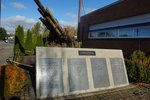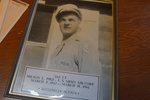



Have you ever gazed on a name and pondered the story behind it? It happened to me once and I wonder if the name came to me to tell its story.
While working in England during the spring of 2009, I visited the Cambridge American Cemetery and Memorial. It was laid out with military precision; the stones of the fallen, marked with their name and date. On the south side, a pool reflected the names on the Walls of the Missing. I turned my attention and gazed on them.
I found a Washingtonian: Second Lieutenant Milton L. Pike, U.S. Army Air Corps. Our state was our only connection.
A few months later I returned home to Blaine, passing by our own war memorial, and whose name should I see but Milton Pike. Immediately, Milton wasn’t just a name but a Blaine man. Was this coincidence or was he speaking to me? A need arose for me to learn more about Milton.
I started my quest at our local American Legion Post 86. They put me in touch with Rod Demente who knew Milton and was able to tell me family information. Milton was born in 1923, along with his twin brother, Howard, sons of a senior U.S. Customs and Border Protection officer in Blaine. Demente stressed both boys were good people.
Most of Milton’s war record came from the autobiography of Walter Pickard, flight commander of Milton’s crew throughout his European air campaign, and the 91st Bomb Group website.
Milton answered the call to arms as World War II raged, volunteering for the U.S. Army Air Corps in 1942. He trained as a navigator in Moses Lake and Kearney Air Base in Nebraska before joining his crew in a Boeing B-17 Flying Fortress plane. The crew got an indication of where they would be posted, and losses were high in that area. They sailed to England aboard the Queen Mary and were posted to 323 Squadron, 91st Bomb Group, 8th U.S. Air Force.
Dodging the Nazi U-Boat menace on the North Atlantic, the ship made port in Glasgow, Scotland December 1, 1943 before reaching their English base at Bassingbourn, which was home to the famous B-17, “Memphis Belle” and known for its comfortable living conditions.
In Bassingbourn, Milton’s crew faced the harsh reality they were to replace lost crews. To this point it had been a distant war. In 13 months, the squadron lost 87 planes, each with 10 on board. After 25 missions were completed a crew could go home. They were surely apprehensive and fearful, yet perhaps young and refusing to face their own mortality.
There continued to be some training in England, but Milton’s war began on January 5, 1944. The crew’s first mission was to attack a Luftwaffe base at Tours in Nazi-occupied France. It was described as “a test met reasonably well.” Milton would fly another 12 missions before the fateful one on March 3, 1944.
On March 3, 1944, Milton and his crew were flying a Boeing B-17G named “My Desire” to bomb Berlin. The weather conspired against the effort with widespread cloud cover. The raid reached Germany’s coast as Berlin was canceled. As the planes circled, they ran into intense anti-aircraft artillery. A hit on an engine caused them to drop out of formation. Dropping their bombs to lighten the plane, there still was not enough power to climb. Then the engine that had been hit caught fire. The pilot dived at high speed to extinguish the fire. In a cloud, flying on instruments, the navigation accuracy diminished and “My Desire” descended.
Milton determined they were over Holland, which was occupied by the Nazis but gave them a better chance of survival than parachuting into the cold North Sea. While evading more ack-ack, they received a direct hit on another engine and the radios. The plane was described to look like a sieve, yet no one sustained injuries.
What happened next is perhaps the most courageous act of the crew. They were down to two engines at full emergency power and were 1.5 hours from England. The commander asked the crew if they wanted to parachute out over Holland or try to make it home. They all wanted to take their chances getting back.
The crew lightened the load throwing guns, ammunition, parachutes and damaged radios overboard, but the plane slowly lost altitude.
Down to 1,500 feet and 15 miles from England, they started passing over an occasional ship that gave them heart. If they had to ditch, they had a chance. At this point, a third engine finally flamed out. This meant that a crash landing had to be made at once. They turned around and tried to land as close to a ship as possible.
Five-foot sea waves did not hamper a smooth landing and the plane stayed intact. No one was injured, but in one dreadful, final blow, the two life rafts had been shot. As the plane sank, the crew went directly into the water. Hypothermia would kill in four minutes.
Milton and nine crewmates gathered around the only partially inflated life raft. The place they stopped was too shallow for the ship to come to the crew’s rescue, so it had to send out its own lifeboat to pick up the downed airmen.
Then fickle fate dealt its last hand as the lifeboat could only accommodate five at a time and would need to make two trips to pick up all 10. The boat took the five nearest, leaving Milton and four to wait for the second shuttle. By the time the lifeboat was set to return 30 minutes later, a British amphibious rescue plane arrived at the scene and reported that Milton, 21, and the other four airmen had perished from the cold. Their bodies were not recovered.
We may draw solace that Milton would not have been in pain as hypothermia took him, though scant consolation for those who loved him.
Seventy-seven years on, Milton’s heroism recorded and the Veterans of Foreign Wars Streets-Pike Post 9474 in Custer bearing his name; may I ask, how do you honor those on November 11? Perhaps gaze on a stone and wonder what’s in a name?
Duncan Massey is a 20-year resident of Blaine, has served as a naval officer and is a member of the Royal Canadian Legion.
Comments
No comments on this item Please log in to comment by clicking here